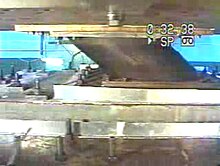
Seismic risk or earthquake risk is the potential impact on the built environment and on people's well-being due to future earthquakes. [1] Seismic risk has been defined, for most management purposes, as the potential economic, social and environmental consequences of hazardous events that may occur in a specified period of time. [2] [3] A building located in a region of high seismic hazard is at lower risk if it is built to sound seismic engineering principles. On the other hand, a building located in a region with a history of minor seismicity, in a brick building located on fill subject to liquefaction can be as high or higher risk.
A special subset is urban seismic risk which looks at the specific issues of cities. Risk determination and emergency response can also be determined through the use of an earthquake scenario.
Determination of seismic risk
The determination of seismic risk is the foundation for risk mitigation decision-making, a key step in risk management. Large corporations and other enterprises (e.g., local governments) analyze their 'portfolio' of properties, to determine how to best allocate limited funds for structural strengthening of buildings, or other risk reduction measures such as emergency planning. In calculating the risk of each facility in the 'portfolio', potential life safety and economic losses due not only to structural damage, but also to equipment, contents and business interruption are considered. Public agencies (local, state governments and federal agencies) similarly analyze their portfolios. The interconnections of infrastructures such as water, road and highway, and electric power systems are also considered. Insurance companies routinely employ estimates of seismic risk in their operations to determine appropriate insurance rates, monitor over-accumulation of policies in a small area, and purchase reinsurance. A simplified method of calculating seismic risk for a given city, involves the use of a street survey. [4] If you know the level of seismic hazard, the damage generally follows established patterns.
Seismic risk is often determined using a seismic modeling computer programs which uses the seismic hazard inputs and combines them with the known susceptibilities of structures and facilities, such as buildings, bridges, electrical power switching stations, etc. The result gives probabilities for economic damage or casualties, for example the HAZUS computer program. [5] While the results can be used as a general measure of seismic risk for types of buildings, the actual seismic risk for any individual building may vary considerably and will depend upon its exact configuration and condition. Acquiring and analyzing the specific data for an individual building or facility is one of the most expensive and daunting aspects of seismic risk estimation. Progress is made if one can calculate the 'fragility' or seismic capacity of the components within a structure. [6]
In 1999, ASTM produced guidelines for reporting seismic loss estimates on commercial properties, commonly known as Probable Maximum Loss or PML reviews. These guidelines specify the scope of work, qualifications of the reviewer, and proper nomenclature for reporting loss estimates. [7]
Reduction of seismic risk
Seismic risk can be reduced by active programs that improve emergency response, and improve basic infrastructure. The concepts of earthquake preparedness can help plan for emergencies arising from an earthquake. Building codes are intended to help to manage seismic risk and are updated as more is learned about the effects of seismic ground motion on buildings. This type of active improvement of mitigation of damage from earthquakes is known as seismic retrofit. [8] However, the changes generally do not immediately improve seismic risk in a community since existing buildings are rarely required to be upgraded to meet the revisions.
See also
Notes
- ^ "EFEHR | What is earthquake risk?". www.efehr.org. Retrieved 2024-04-08.
- ^ Baker, Jack; Bradley, Brendon; Stafford, Peter (2021). Seismic Hazard and Risk Analysis. Cambridge University Press. ISBN 9781108425056. Retrieved February 9, 2022.
- ^ Seismic risk evaluation for an urban centre. 250TH ANNIVERSARY OF THE 1755 LISBON EARTHQUAKE
- ^ Simple Survey Procedures for Seismic Risk Assessment In Urban Building Stocks
- ^ "Fema: Hazus". www.fema.gov. Archived from the original on 30 January 2009. Retrieved 17 January 2022.
- ^ "Fire Research Division" (PDF). NIST. 11 December 2008.
- ^ "Seismic Reports | ASTM E2026 - Cascade Crest Consulting Engineers". Archived from the original on 2013-09-14. Retrieved 2013-02-26.
- ^ Craig Taylor and Erik VanMarcke, ed. (2002). Acceptable Risk Processes: Lifeline and Natural Hazards. Reston, VA: ASCE, TCLEE. ISBN 9780784406236. Archived from the original on 2013-12-03.
External links
- C. Allin Cornell
- HAZUS - Seismic Risk Program for the US
- An All HAZUS Web Space
- HAZUS Community website
- Infrastructure Risk Research Project at The University of British Columbia, Vancouver, Canada
- OIKOS - Educational European project based on Google Maps Mashups
- EMSC : Seismic real-time information
- Diagnose the impact of global earthquakes from direct and indirect eyewitnesses contributions